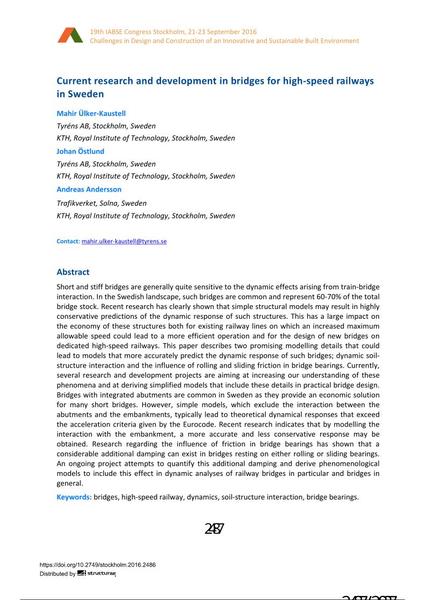Current research and development in bridges for high-speed railways in Sweden

|
|
|||||||||||
Bibliographic Details
| Author(s): |
Mahir Ülker-Kaustell
(Tyréns AB, Stockholm, Sweden; KTH, Royal Institute of Technology, Stockholm, Sweden)
Johan Östlund (Tyréns AB, Stockholm, Sweden; KTH, Royal Institute of Technology, Stockholm, Sweden) Andreas Andersson (Trafikverket, Solna, Sweden; KTH, Royal Institute of Technology, Stockholm, Sweden) |
||||
|---|---|---|---|---|---|
| Medium: | conference paper | ||||
| Language(s): | English | ||||
| Conference: | IABSE Congress: Challenges in Design and Construction of an Innovative and Sustainable Built Environment, Stockholm, Sweden, 21-23 September 2016 | ||||
| Published in: | IABSE Congress Stockholm, 2016 | ||||
|
|||||
| Page(s): | 2487-2494 | ||||
| Total no. of pages: | 8 | ||||
| Year: | 2016 | ||||
| DOI: | 10.2749/stockholm.2016.2486 | ||||
| Abstract: |
Short and stiff bridges are generally quite sensitive to the dynamic effects arising from train-bridge interaction. In the Swedish landscape, such bridges are common and represent 60-70% of the total bridge stock. Recent research has clearly shown that simple structural models may result in highly conservative predictions of the dynamic response of such structures. This has a large impact on the economy of these structures both for existing railway lines on which an increased maximum allowable speed could lead to a more efficient operation and for the design of new bridges on dedicated high-speed railways. This paper describes two promising modelling details that could lead to models that more accurately predict the dynamic response of such bridges; dynamic soil- structure interaction and the influence of rolling and sliding friction in bridge bearings. Currently, several research and development projects are aiming at increasing our understanding of these phenomena and at deriving simplified models that include these details in practical bridge design. Bridges with integrated abutments are common in Sweden as they provide an economic solution for many short bridges. However, simple models, which exclude the interaction between the abutments and the embankments, typically lead to theoretical dynamical responses that exceed the acceleration criteria given by the Eurocode. Recent research indicates that by modelling the interaction with the embankment, a more accurate and less conservative response may be obtained. Research regarding the influence of friction in bridge bearings has shown that a considerable additional damping can exist in bridges resting on either rolling or sliding bearings. An ongoing project attempts to quantify this additional damping and derive phenomenological models to include this effect in dynamic analyses of railway bridges in particular and bridges in general. |
||||
| Keywords: |
bridges bridge bearings soil-structure interaction dynamics high-speed railway
|
||||

